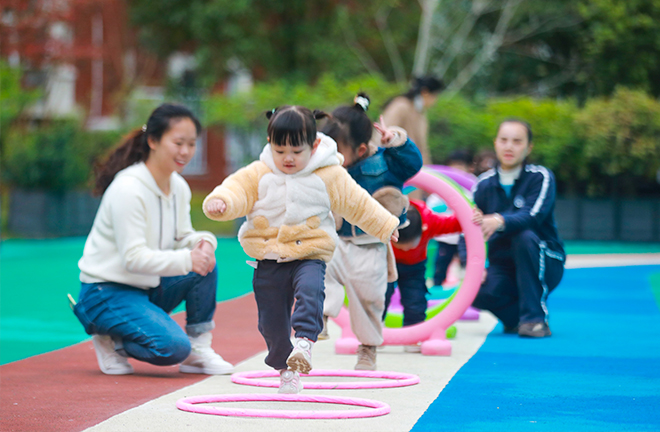China embraces shifts in marriage and childbirth culture

Children play at a nursery in Qianxi City, Guizhou Province, on Nov. 20, 2024. Photo: IC PHOTO
Boosting fertility rates is a long-term and daunting task to any country. To adapt to the new normal and address emerging demographic challenges, China has introduced a series of guidelines aimed at improving childbirth policies to promote long-term balanced demographic development and build a birth-friendly society. For example, in 2021, the CPC Central Committee and the State Council issued the Decision on Optimizing the Family Planning Policy to Promote Long-term and Balanced Development of the Population, and in 2024, Several Measures on Accelerating the Refinement of Birth Support Policies and the Building of a Birth-friendly Society was unveiled. These documents stress the necessity and urgency of constructing a new marriage and childbirth culture to support high-quality population development.
The concept “marriage and childbirth culture” is extensive and complex, encompassing various dimensions of human life, including language, literature, art, religion, philosophy, science and technology, customs, and moral norms. This culture subtly shapes individual thought and behavior as well as broader societal operations for its stable, inherent, and transmissible nature. In recent years, China has experienced delays in the average age of first marriage and first childbirth, an increasing proportion of unmarried individuals, persistently low fertility rates, and a trend toward smaller household sizes. Studies reveal that while economic factors primarily drive fertility decline in its initial stages, non-economic factors, such as social and cultural influences, become increasingly significant once fertility rates drop below replacement levels.
Marriage and childbirth culture encompasses the collective perceptions and attitudes toward marriage, reproduction, and family relationships. In the new era, the characteristics of younger generations’ views and resulting low fertility rates are reflected in the following aspects:
First, individualism is reshaping the norms around marriage and childbirth. The traditional “social clock” for these milestones has been disrupted, with young people increasingly seeking personalized life paths. Reproduction is no longer seen as an inherent obligation for women. The emergence of new gender narratives, such as the “heroine” label, has resonated with many young women, contributing to a decline in fertility intentions as personal autonomy takes precedence.
Second, cultural rationality has begun to overshadow economic rationality in decisions about marriage and childbearing. Unlike prior generations who were inclined to prioritize maximizing personal benefits and resource utilization efficiency, younger individuals tend to give priority to happiness. They emphasize “responsible childbirth,” carefully assessing their ability to provide high-quality parenting and education in both the near and distant future. Furthermore, widespread concern about vicious societal competition and pervasive educational anxieties elevate the implicit barriers to marriage and reproduction, further eroding confidence in these commitments.
Third, ethical considerations, rooted in China’s traditional clan-based kinship culture, also play a role. With “loyalty” and “filial piety” as core values, traditional family ethics have focused on balancing responsibilities within the family, such as reconciling women’s career and reproductive roles, managing caregiving and elder care duties among individuals or across generations, and aligning individual reproductive goals with national policies. Fertility motivations have shifted from familial and utilitarian priorities to a focus on personal fulfillment.
Fourth, shifts in views on marriage and childbirth are a universal phenomenon across modernized countries. In China, younger generations’ perspectives on these matters have been reshaped amidst rapid economic growth and social transformation. For many “only children,” their parents’ values and behaviors influence their own attitudes through both inheritance and reflection. While parental preferences regarding family size, timing, and gender often guide younger generations, counter-narratives based on personal experiences also emerge, challenging traditional reproductive expectations.
Fifth, the emotional dimensions of marriage and childbirth are gaining prominence. The decline in family size and the diversification of family structures have weakened traditional roles such as childrearing and elder care. The pragmatic emphasis on “continuing the family line” and “raising children for old age” has largely been replaced by the pursuit of emotional satisfaction and happiness from partners and children. However, this shift toward emotional value can introduce instability to marriage and family life, necessitating adaptive policy measures to address these emerging challenges.
Zhang Lei is an associate professor and deputy director of the Institute of Population Research at Peking University.
Edited by CHEN MIRONG
